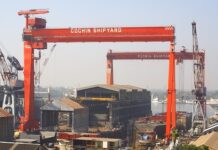
Disruptions in the Red Sea contributed to declines in the connectivity of Eastern Mediterranean ports, a region highly affected by the Houthis attacks, as the Suez Canal and Bab el-Mandeb straights are connected to the maritime routes crossing some major ports in the region.
The analysis took into consideration the ports of Piraeus, Limassol, Ashdod, Mersin, Port Said, Alexandria and Mersin, and concentrated on the summer months of 2024.
The analysis revealed the below-mentioned conclusions:
Container traffic through the Suez Canal remained robust with consistent transits, emphasizing its pivotal role in maritime trade. The canal’s performance alongside the connectivity trends in nearby ports offers insights into regional trade health and strategic maritime operations.
Given the data retrieval issue, it can be assumed that Bab el-Mandeb also maintained similar traffic levels, suggesting that the level of stability in this critical chokepoint has returned.
This stability, combined with the actual data from the Suez Canal, points towards sustained reliance on these routes despite regional fluctuations in port performance and the disruptions caused by Houthis.
By intertwining chokepoint activities with port connectivity, it becomes evident that while individual ports face unique challenges, major maritime routes continue to support substantial global trade flows.
This resilience highlights the strategic importance of these maritime chokepoints and the interconnected nature of port operations and global shipping routes.
However, the total transits vary from region to region, indicating that the disruptive phenomenon due to Houthis attacks, still affects the Bab el-Mandeb chockepoint. This is evident by the decline of the total transits passing through Bab el-Mandeb which stands on the gateway of the Red Sea.

The analysis examined also the port efficiency of the Eastern Mediterranean ports for the last quarters of 2024, in order to assess if there were significant turbulences, due to the heated situation in the shores of Yemen.
In 2024, Eastern Mediterranean port connectivity exhibited mixed trends. Limassol and Port Said showed increases in connectivity, which could be indicative of strategic improvements and regional trade favorabilities.
Conversely, significant declines were observed in Alexandria, Piraeus, Ashdod, Haifa, and Mersin, likely due to various operational challenges or competitive dynamics.

Egypt’s Port Said saw the largest positive improvement in connectivity, with an increase of 6,23% from Q1 to Q3 2024. The notable improvement in suggests that this port has seen an increase in efficiency, capacity, or attractiveness as a shipping hub.
Cyprus’ Limassol also experienced a slight increase, indicating a growing trend in connectivity. The slight increase in connectivity points to steady improvements in the port’s operational capabilities or its strategic importance in the region, possibly indicating that it is benefiting from increasing regional trade or better integration into shipping networks.
Greece’s Piraeus experienced the largest decline, with a significant drop of 8,39% in its connectivity index, while Mersin face a sharp decline of 12,2%. The significant declines in connectivity could indicate regional or operational challenges.
It seems that there was an overall declined trend for all the ports, despite the slight increases of the container transits during the summer months. This could indicate that the goals of the Houthis to cause a supply chain disruption really had an effect on major Eastern Mediterranean ports.
However, the growing trend of port Said indicates that Egypt demonstrated a resilience during this time and could possibly leveraged the slightly improves container transits.
This could be attributed to the infrastructure investments by the United Arab Emirates and Saudi Arabia the last two years, which aimed exactly to ensure the economic stability of Egypt.
On the other hand, more exposed economies like the one of Greece, Israel and Turkey showed a significant decline trend, as their major ports were highly affected.
Small states like Cyprus, maybe due to their proximity to port Said, managed to leverage a small percentage of growth.
Overall, the region of the Eastern Mediterranean showed a decline in terms of connectivity over time, indicating that the regional challenges posed by the disruptions in the Red Sea highly affects the operational environment of the maritime trade.





